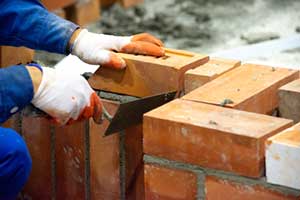Unlocking the Secrets of Sustainable Masonry Building And Construction Practices for Eco-Friendly Buildings
Among the myriad approaches to eco-friendly building, lasting masonry construction stands out as a tried and true and long lasting method that holds a wealth of untapped possibility. From the choice of products to ingenious building and construction methods, the keys to achieving sustainability within stonework building are diverse and appealing.
Advantages of Sustainable Masonry Building
Embracing sustainable stonework construction techniques not just lowers environmental impact but additionally provides long-lasting economic advantages to builders and neighborhoods. By using products like recycled bricks, obstructs, and rocks, builders can substantially lower the carbon footprint of their projects while promoting resource efficiency. Additionally, sustainable masonry construction strategies, such as appropriate insulation and thermal mass homes, can improve energy efficiency within structures, resulting in reduced functional costs in time.
Moreover, the resilience and durability of masonry structures add to long-lasting economic advantages. Buildings created making use of lasting masonry techniques frequently need less repair and maintenance, equating to cost financial savings for home builders and property proprietors. The longevity of stonework materials also ensures that structures stay stable and safe, decreasing the need for frequent remodellings or replacements.
Eco-Friendly Stonework Products
Utilizing environmentally friendly stonework materials is a pivotal action in the direction of improving the sustainability of building and construction methods and reducing ecological influence while making the most of lasting financial advantages. Sustainable stonework products are sourced, produced, and utilized in a fashion that reduces total ecological impact. Products such as recycled bricks, recovered stone, and sustainable cinder block are coming to be significantly popular choices for eco-conscious contractors. Recycled bricks, as an example, not only divert waste from land fills yet additionally need much less power to produce compared to brand-new bricks. Redeemed rock supplies an one-of-a-kind visual allure while minimizing the need for new quarrying. Sustainable concrete blocks incorporate recycled aggregates and might include improved insulation residential or commercial properties, adding to energy efficiency in structures.
In addition, natural materials like adobe, rammed earth, and straw bundles give exceptional thermal mass buildings, lowering the requirement for heating and cooling power. These materials are frequently locally available, advertising local economic climates and lowering transportation-related carbon emissions. By picking eco-friendly masonry materials, building and construction tasks can substantially decrease their ecological footprint and add to the development of much healthier, much more lasting built environments.
Energy-Efficient Stonework Techniques
Energy performance plays a critical duty in enhancing the sustainability of stonework building practices. By carrying out energy-efficient stonework strategies, builders can considerably reduce the general energy consumption of a structure, resulting in reduced operational expenses and a smaller sized environmental impact. One crucial energy-efficient masonry technique is the use of thermal mass, which includes incorporating dense products like concrete or brick into the structure's structure to take in and store heat. This assists control indoor temperatures, lowering the demand for mechanical heating and cooling systems.

Technologies in Sustainable Masonry
Current advancements in lasting masonry practices have brought around cutting-edge techniques that are reshaping morris concrete design the building and construction industry. One such advancement is the development of self-healing concrete, which utilizes microorganisms embedded within the concrete to recover fractures autonomously. This development not just minimizes maintenance prices yet likewise boosts the sturdiness of stonework structures, adding to their sustainability.
Another significant development is using recycled accumulations in masonry construction - masonry contractor. By integrating materials such as smashed ceramic waste or recycled glass right into concrete mixes, building contractors can lower the ecological effect of building and construction jobs while keeping structural stability. This practice not just draws away waste from landfills however likewise conserves natural deposits, making it a crucial development in lasting masonry building and construction
Additionally, the integration of digital design devices, such as Building Info Modeling (BIM), is transforming the way stonework structures are prepared and built. BIM allows for even more precise calculations, lowered material waste, and enhanced power look at these guys effectiveness, ultimately leading to more lasting structure techniques. These technologies jointly signify an encouraging future for sustainable masonry construction in the era of environmentally friendly structures.
Future Trends in Masonry Sustainability
With the ingenious strides made in sustainable masonry practices, the future fads in stonework sustainability are positioned to more transform the building market. One of the essential patterns forming the future of stonework sustainability is the increased combination of innovation. Developments such as Building stamped concrete installers near me Details Modeling (BIM) and digital truth simulations are being utilized to optimize stonework construction procedures, resulting in decreased material waste and improved energy effectiveness in buildings.
Moreover, the development of novel lasting materials is readied to play a considerable role in boosting the eco-friendliness of masonry building and construction. masonry contractor. Advancements like self-healing concrete, recycled aggregates, and bio-based binders are acquiring traction for their capability to minimize ecological impact while maintaining structural integrity

Verdict
Finally, lasting stonework building techniques provide many benefits for eco-friendly structures. By making use of environmentally friendly materials and energy-efficient methods, stonework can add to a more lasting built environment. Innovations in sustainable masonry are continuously being established to even more improve the ecological efficiency of structures. Looking in the direction of the future, the pattern of stonework sustainability is expected to grow, resulting in more eco-friendly and energy-efficient building and construction practices in the years to come.